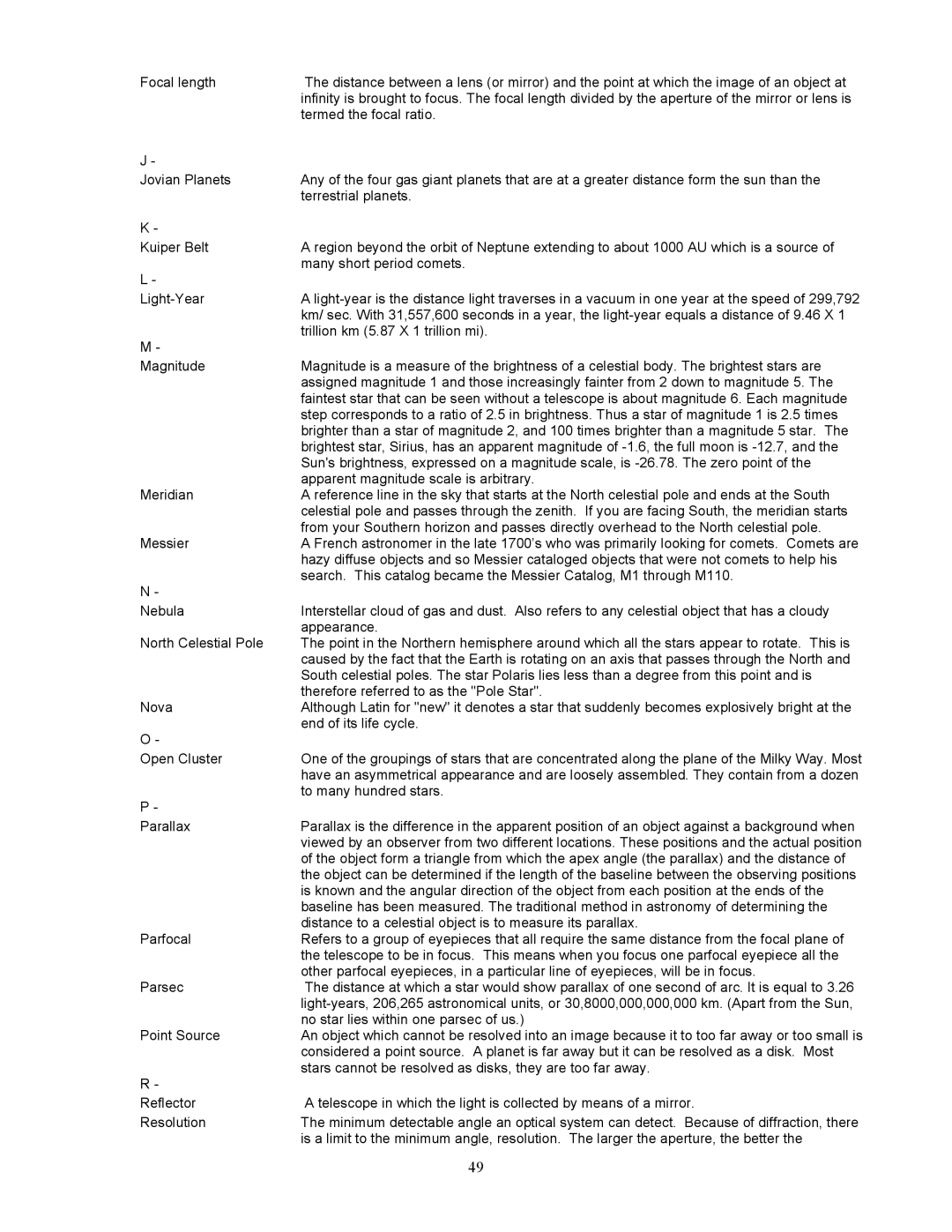Focal length | The distance between a lens (or mirror) and the point at which the image of an object at |
| infinity is brought to focus. The focal length divided by the aperture of the mirror or lens is |
| termed the focal ratio. |
J - |
|
Jovian Planets | Any of the four gas giant planets that are at a greater distance form the sun than the |
| terrestrial planets. |
K - |
|
Kuiper Belt | A region beyond the orbit of Neptune extending to about 1000 AU which is a source of |
L - | many short period comets. |
| |
A | |
| km/ sec. With 31,557,600 seconds in a year, the |
M - | trillion km (5.87 X 1 trillion mi). |
| |
Magnitude | Magnitude is a measure of the brightness of a celestial body. The brightest stars are |
| assigned magnitude 1 and those increasingly fainter from 2 down to magnitude 5. The |
| faintest star that can be seen without a telescope is about magnitude 6. Each magnitude |
| step corresponds to a ratio of 2.5 in brightness. Thus a star of magnitude 1 is 2.5 times |
| brighter than a star of magnitude 2, and 100 times brighter than a magnitude 5 star. The |
| brightest star, Sirius, has an apparent magnitude of |
| Sun's brightness, expressed on a magnitude scale, is |
| apparent magnitude scale is arbitrary. |
Meridian | A reference line in the sky that starts at the North celestial pole and ends at the South |
| celestial pole and passes through the zenith. If you are facing South, the meridian starts |
| from your Southern horizon and passes directly overhead to the North celestial pole. |
Messier | A French astronomer in the late 1700’s who was primarily looking for comets. Comets are |
| hazy diffuse objects and so Messier cataloged objects that were not comets to help his |
N - | search. This catalog became the Messier Catalog, M1 through M110. |
| |
Nebula | Interstellar cloud of gas and dust. Also refers to any celestial object that has a cloudy |
| appearance. |
North Celestial Pole | The point in the Northern hemisphere around which all the stars appear to rotate. This is |
| caused by the fact that the Earth is rotating on an axis that passes through the North and |
| South celestial poles. The star Polaris lies less than a degree from this point and is |
| therefore referred to as the "Pole Star". |
Nova | Although Latin for "new" it denotes a star that suddenly becomes explosively bright at the |
O - | end of its life cycle. |
| |
Open Cluster | One of the groupings of stars that are concentrated along the plane of the Milky Way. Most |
| have an asymmetrical appearance and are loosely assembled. They contain from a dozen |
P - | to many hundred stars. |
| |
Parallax | Parallax is the difference in the apparent position of an object against a background when |
| viewed by an observer from two different locations. These positions and the actual position |
| of the object form a triangle from which the apex angle (the parallax) and the distance of |
| the object can be determined if the length of the baseline between the observing positions |
| is known and the angular direction of the object from each position at the ends of the |
| baseline has been measured. The traditional method in astronomy of determining the |
| distance to a celestial object is to measure its parallax. |
Parfocal | Refers to a group of eyepieces that all require the same distance from the focal plane of |
| the telescope to be in focus. This means when you focus one parfocal eyepiece all the |
| other parfocal eyepieces, in a particular line of eyepieces, will be in focus. |
Parsec | The distance at which a star would show parallax of one second of arc. It is equal to 3.26 |
| |
| no star lies within one parsec of us.) |
Point Source | An object which cannot be resolved into an image because it to too far away or too small is |
| considered a point source. A planet is far away but it can be resolved as a disk. Most |
R - | stars cannot be resolved as disks, they are too far away. |
| |
Reflector | A telescope in which the light is collected by means of a mirror. |
Resolution | The minimum detectable angle an optical system can detect. Because of diffraction, there |
| is a limit to the minimum angle, resolution. The larger the aperture, the better the |
49
